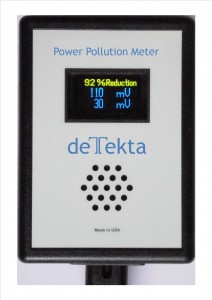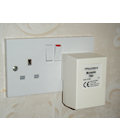What is Dirty Electricity (DE)?
 Dirty electricity (DE), also known as dirty mains, dirty power, or electrical pollution, is a term that describes the problem of electromagnetic noise being on the mains wiring of a house, when it isn’t supposed to be. DE occupies a part of the spectrum in-between the power frequency fields created by powerlines and substations, and the microwaves produced by mobile phone masts and other modern wireless devices.
Dirty electricity (DE), also known as dirty mains, dirty power, or electrical pollution, is a term that describes the problem of electromagnetic noise being on the mains wiring of a house, when it isn’t supposed to be. DE occupies a part of the spectrum in-between the power frequency fields created by powerlines and substations, and the microwaves produced by mobile phone masts and other modern wireless devices.
Many claims have been made associating Dirty Electricity with a wide variety of negative health effects, including cancer, asthma, chronic fatigue syndrome, diabetes, ADD, autism and a number of neurological disorders.
DE consists of high frequency “electrical noise” that has become superimposed on your wires. It includes transient spikes from inductive loads like motors being switched on and off. Most of the published work on this uses the Stetzer Microsurge meter which measures noise between about 2 kHz and 120 kHz. Until now the only DE Meter available.
dLAN network adapters also put RF signals on your mains wiring and it is good to switch them off at night. The levels are vanishingly tiny when compared with WiFi signals, however they may affect electrosensitive people. Please note: dLANs use frequencies above 150 kHz and are not detected by the Dirty Electricity meter.
Dirty Electricity can travel into your house on the local electricity supply, especially if any neighbours have Solar Panels fitted. The Inverters used with Solar Panel installations can create huge amounts of Dirty Electricity which is then passed back into the Grid and delivered into homes/offices supplied on that same supply line. This is a growing concern with more and more Solar Panels being installed. Which is why it is imperative to be able to measure DE levels in your home/office on a regular basis (see below for details on our Power Pollution Meter) as levels of ‘imported’ DE are increasing every day. Some of these levels of DE produced by Solar Panels can be extremely high, to the extent they become detrimental to our and our children’s health. DE is is often generated by devices in your home. In the UK, the incoming supply is normally quite clean, (but becoming much less so as more Solar Panels are being fitted) so DE is also generated by internal devices, though large blocks of flats and similar multi-occupancy living spaces can have a lot of shared DE sources. Bad electrical connections in the external supply lines to your home, or arcing on high-voltage feeder lines, can bring DE into your home along with the electricity supply. If you have high readings when everything in the house is switched off, then you need the DE filters to be placed as close as possible to the incoming mains supply – usually close to your fuse box / consumer unit. However, the use of Solar Panels is now a major concern when it comes to the creation of dirty electricity. We will share more shortly. The Dangers of using Solar Panels
Common large contributors to DE include Solar Panels, Smart Meters, dimmer switches, televisions, fluorescent light bulbs (including the relatively new CFLs, or energy efficient bulbs) and computers. Electrical (Chair) Recliners and Electrical Adjustable Beds also create very high levels of DE through the Transformers used to convert the ACV to DCV. Any device that has a “switched mode power supply” will naturally create a lot of noise, but it’s hard to tell exactly which devices do have them and which ones don’t. It’s fairly new technology, so most modern, energy efficient, electronic devices now have them. Older, non-electronic devices such as lamps, ovens, or devices that run on motors, don’t normally create much DE.
Further information regarding Dirty Electricity (DE)
Your electrical supply is supposed to have just a 50 Hz sine wave on it, but this is rarely the case. There are almost always significant 2nd and 3rd harmonics (100 and 150 Hz in Europe, 120 and 180 Hz in USA), but these are not thought to be any more harmful than the pure sine wave.
DE consists of high frequency “electrical noise” of 1000 Hz (1 kHz) and upwards that has become superimposed on your wires. It includes transient spikes from inductive loads like motors being switched on and off. Most of the published work on this uses the Stetzer Microsurge meter which measures noise between about 2 kHz and 120 kHz.
dLAN network adapters also put RF signals on your mains wiring and it is good to switch them off at night. dLANs use frequencies above 150 kHz that extend up to several MHz and are not detected by some Dirty Electricity meters like the Stetzer. However, the NEW DE Meter we are about to launch (see below) will be able to measure these levels. It will measure DE from as low as 2KHz up to 10MHz. High speed/bandwidth (500 Mbps and faster) dLANs produce electrical RF noise up into the 100s of MHz.
High frequency noise on electricity supplies is a problem that has been know about since the 1920s. The original suggestion for a general use meter came in the 1980s from a Professor of Electrical Engineering in the USA called Martin Graham. He filed a US Patent that suggested possible circuitry for a suitable meter and the theory behind it. Working with Dave Stetzer, who runs an electrical company in the USA, he then produced a practical meter. It is measured in what have become known as GS units. The term DE units is usually taken to have the same meaning.
The capacitance of a human to the live wires will usually be less than 800 picofarads and the current through the human will be proportionately lower. The current flow through the human will also depend on how the capacitance of the human to the wire is distributed over the person. This is important since it is the current flowing inside the body and where it is flowing that determines the effect it will have on the human.
The Stetzer Dirty Electricity Meter (described above) measures the current in a 800 picofarad capacitor connected across the terminals of the outlet into which it is plugged. One GS unit is .02 micro amperes. A meter reading of 50 would indicate a current of one microampere.
The frequency band covered by the Stetzer Dirty Electricity Meter is about 10 kHz to 120 kHz. If only one frequency sine wave is present, the meter reading is 0.24 times the rms voltage in millivolts times the frequency in kilohertz. In current terms, one GS unit is equal to .02 micro amperes. 900 GS units would be equal to 18 micro amperes.
However, our brand new a brand new DE Meter supersedes the Stetzer Meter, measuring DE from as low as 2KHz way up to 10MHz. This unit also offers before DE Filter and after fitting DE Filter readings whilst also showing the percentage reduction in levels of DE achieved – see below for more details.
Solution to Dirty Electricity
Dirty Electricity Meter – Introducing The Brand New State of the Art:

Power Pollution Meter – Built with your Health & Safety in mind!
Key Features
 Measures broadest range of Dirty Electricity (EMI) signals available
Measures broadest range of Dirty Electricity (EMI) signals available
Measures Dirty Electricity (EMI) signals from 2 Kilohertz up to 10 Megahertz, a range that extends approximately 10 times lower and 20 times higher than the range covered by other dirty electricity meters on the market. Therefore you can be reassured that this Meter will detect levels of DE thoroughly and accurately.
First plug-in DE Meter to measure dirty electricity in millivolts
Shows measurements in internationally accepted, standardized electrical units (mV)
Easy to use
Simply plug the meter into any outlet to see how much DE/EMI is on the circuit near the outlet. After a few seconds the top reading will stop flashing and show an average reading on the circuit. Plug a dirty electricity filter (or more) into other outlets nearby and the meter will show the new level of DE/EMI underneath and the percent of total DE/EMI reduction with use of the filter/s.
Makes ‘BEFORE filter’ and ‘AFTER filter’ comparisons easy
DE/EMI readings before and after dirty electricity filter/s installed in an outlet are shown simultaneously on the same display screen (in mV). ‘After filter’ display screen also shows the percentage (%-age) reduction in total DE/EMI between 2 Kilohertz and 10 Megahertz. The widest DE measurement range on the market.
Includes special audio function – HEAR the difference!
You can listen to the amount of dirty electricity on a circuit when the DE Meter is plugged in. (Similar to listening to microwave radiation levels when using the Acousticom 2 or the Acoustimeter Microwave Monitors. ) Hear the ‘noise’ decrease when you install the DE Filter/s. Makes the correct placing and siting of the DE Filters very easy when trying to discern the best position (sockets) to obtain the maximum results possible in reduction of dirty electricity.
AVAILABLE TO ORDER @£145.00! This product is backed and supported by Alasdair Philips of Powerwatch and EM Fields. See our Dirty Electricity Meter Page here for more details
Electropulse (DE2) Filter
Fitting a few “Electropulse Filters” (or Dirty Electricity Filter) in your house helps reduce the Dirty Electricity, by lowering high-frequency noise on your house wiring. They plug in (and occupy) a standard 13A mains power socket.
Recommendations: We suggest a maximum of one-per-room and, in the first instance, probably just starting with two or three for the whole house. Typically a small Flat with one Socket Circuit would only require two DE Filters. A typical house with an upstairs and two Socket Circuits would require three DE Filters: two for the downstairs circuit, one in Lounge because this is generally where most of the electrical equipment is, and one in Kitchen. The third one is for the upstairs socket circuit. A larger house, one with more than two socket circuits, would require one more DE Filter for each extra socket circuit. Though always be guided by the DE Power Pollution Meter to determine the best results, number and positioning of the Filters.
Please note these DE2 Filters are an update to the old DE1 Electropulse Filters and that contrary to what some other sites say, you do not need 10-20 DE Filters in a house! In fact this many would be counterproductive and may make the situation worse. Our Electropulse Filters (DE Filters) are manufactured in the UK and are designed to cope with our higher voltage system of 230-250v. Rather than being based on the US 110v system that other DE Filters are based upon.
Houses that are badly affected by DE would generally have GS Levels (measured in mV) in the 400s/1200s, and even higher in some cases, up to 1800. The use of the DE Filters is designed to reduce these DE Levels (spikes of bad energy/information if you like) down to a more natural 40-60mV. Which is what you would expect from a 50-60Hz 230-250v system like the one we have in the UK. That is exactly what the DE Filters manage to achieve, with only 2-4 Filters. You DO NOT need to use more Filters than this, unless you have extremely bad levels of DE coming into your hole through the power supply. With our brand new DE Meter you would be looking to reduce DE Levels to around 100mV or lower with the use of DE Filters.
How To Use: Simply plug in the Filter and if the socket has a switch, switch it on. The Filters do not consume any power, though they do need to be ‘connected’ to the electricity to work, so your utility bills will not be affected.
**Please note that they don’t lower the power frequency electric fields created by house wiring, only the high-frequency noise between the 230 volts phase and the neutral.
Technical detail: The unit contains a 15 microfarad a.c. mains-voltage rated capacitor and discharging resistors. The units are fully approved to European safety standards and are internally fused and shielded, unlike others on the market.
Please note that these are fitted with a UK style plug, and will require a socket adapter to be used in many other countries. You do not require an earth pin on your system for the filter to work correctly.
Electropulse (DE2) Filters – £44.50 each – NOW AVAILABLE

